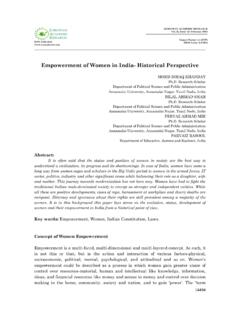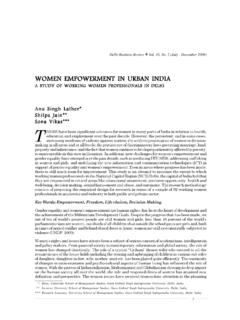Transcription of Empowerment of Women in India: A Critical Analysis
1 IOSR Journal Of Humanities And Social Science (IOSR-JHSS) Volume 9, Issue 2 (Mar. - Apr. 2013), PP 45-52 e-ISSN: 2279-0837, p-ISSN: 2279-0845. 45 | Page Empowerment of Women in india : A Critical Analysis Dr. B. Nagaraja , Associate Professor Department of Economics Sri Venkateswara University College of Arts Sri Venkateswara University TIRUPATI Abstract: The present paper primarily deals with Empowerment of Women in india and throws light on particularly agency approach to measure Women Empowerment . Divided into three sections, this paper presents the illustration of modern approach to Empowerment in Section-I; an overview of the efforts put in india for empowering Women in Section-II and analyses the degree of achievement of Empowerment by adopting some of the modern indicators in Section-III.
2 This paper hinges fundamentally on secondary sources of data related to india , published by National Family Health Survey, National Sample Survey Organization and some of the research papers. Key words: Empowerment , Agency, Gender Gap, Access to Resources, Control over Resources, Economic participation and opportunity. I. Introduction: The concept of Empowerment traces its history in the mid-17th century with the legalistic meaning to invest with authority . Thereafter, this concept was modernized to mean to enable or permit . After 1980 s, the novel concept of measuring economic development through human development focusing on political Empowerment linkage with feminist discourse went a long way in shaping the idea of Women s Empowerment .
3 During 1990 s economists agued that development if not engendered, is endangered and the major component of the global society Women are left outside the purview of the fruits of development and planning, we cannot achieve the desired goal of a developed status of an economy, whether it is developed or developing . The United Nations has shown concern for Women Empowerment evident in Millennium Development Goals to trace the progress of Women Empowerment across the world. SECTION I APPROACHES TO Empowerment We know well that in general terms, the position of Women in society is still low compared to their counterparts. Particularly in developing countries Women have to face the glass ceiling . The major reason being the discrimination between man and woman on the basis of sex has created various types of gender biases.
4 Hence, efforts were made to remove discrimination against females and to establish equality has become the part of the global movement emphasized in all the four World Conferences on Women including the Beijing Conference in 1995. The World Bank has identified Empowerment as one of the key constituent elements of poverty reduction and as a primary development assistance goal. The promotion of Women s Empowerment as a development goal is based on the dual argument that social justice is an important aspect of human welfare. The Policy Research Report of the World Bank has also identified gender equality both as a development objective and as a means to promote growth, reduce poverty and promote better governance. Beijing Declaration (1995) presented Women s Empowerment as a key strategy for development and stated that Women s full participation on the basis of equality in all spheres of society, including participation in the decision making process and access to power are fundamental for the achievement of equality, development and peace.
5 Another line of thought in development literature has promoted social inclusion in the institutions as the key pathway to Empowerment of individuals and capitalism top-down approaches to development and /or poverty itself are seen as sources of disempowerment. This process of social inclusion was viewed as a process that removes the institutional barriers and the enhancement of incentives to increase the access of diverse individuals and groups to assets and development opportunities (Beteta Hanny,2006). The growth of civil society and participatory development methods at both macro and micro levels of society were also proposed as the mechanisms by which Empowerment could take place. This approach to Empowerment focuses on State and Civil Society institutions and interpersonal gender dynamics within the household as a part of the equation of social exclusion and in need of directed efforts at change.
6 Empowerment Of Women In india : A Critical Analysis 46 | Page The Modern Approach: In recent years the concept of Empowerment was modified to include the power in plural form as powers . This powers approach was picked up by several feminist bodies and development NGOs which have argued that Empowerment process should be broken down in four levels of power power over, power to, power with and power within. A revised definition of poverty during the reforms period brought out a new dimension of Empowerment . Haschemi and Schuler (1993) have identified six dimensions of Empowerment based on activities of Women identified as important for their day-to-day functioning. The concept Poverty was also redefined as lack of real opportunity and ultimately a matter of capability deprivation.
7 Hence, it was argued that the basic objective of development was the expansion of human capabilities (Jean Dreze and Amartyasen, 1995). It was also argued that expansion of human capabilities empowers the people and facilitates the reduction of social and economic inequalities. Attempts were made to separate the gender and economic components of Empowerment by combining the models of Empowerment proposed by Kabeer (1999) and England (2000)/ Kabeer (1999) identified three main elements of Empowerment : The first one is the preconditions of Empowerment which include economic as well as human and social resources. The second one is achievements . Gender norms and economic resources must act as preconditions to exercise the power that positively affects the demographic outcomes.
8 (Social Opportunities) and also to have an independent influence on these achievements . Malhotra (2002) used the definition of Empowerment suggested by Kabeer (1999) and argued that Empowerment is the expansion of people s ability to make strategic life choices in a context where this ability was previously denied to them . To be precise, it could said that to be empowered means to exercise more power than other Women in the same context . Based on these arguments, efforts were made to build models that separate the gender and economic components of Empowerment proposed by Kabeer (1999) and England (2000) as shown in fig. 1. : Conceptual Model of Gender and Women Empowerment Source: Jill Williams (2005) Measuring Gender and Women s Empowerment Using Confirmatory Factor Analysis , IBS Working Paper, PAC- 2005-01.
9 Of late, the Human Development Reports have been emphasizing on thinking about equality in terms of capabilities because inequalities in outcomes are largely the product of unequal access to capabilities. The Human Development Reports have introduced Gender Related Development Index (GDI) (to measure average achievements in long and healthy life, knowledge and a decent standard of living which account for inequalities between men and Women ) , Gender Empowerment Measure (GEM) (which measures gender inequality) and Gender Inequality Index (GII- Human Development Report-2010)(which measures the losses due to gender inequalities in reproductive health, Empowerment and labour market participation). The Human Development Report -2010 observed that human development is a participatory and dynamic process and people are the real wealth of a nation and the process has three important components viz.
10 , well-being, Empowerment and agency and justice (equality). Particularly it was stressed that Empowerment requires both agency and supportive institutional structures and Empowerment is about people as individuals and acting in groups. The World Development Report-2012 observed that greater gender equality enhances productivity, improves development outcomes for the next generation and make institutions more representative. The United Nation Population Fund (2003) believed that gender inequality holds back economic growth of individuals, development of countries and the evolution of societies and economic growth and social equality should go hand in hand. The World Economic Forum has been publishing The Global Gender Gap reports since 2006 and its Report- 2012 focused on three basic concepts underlying the Global Gender Gap Index.



















